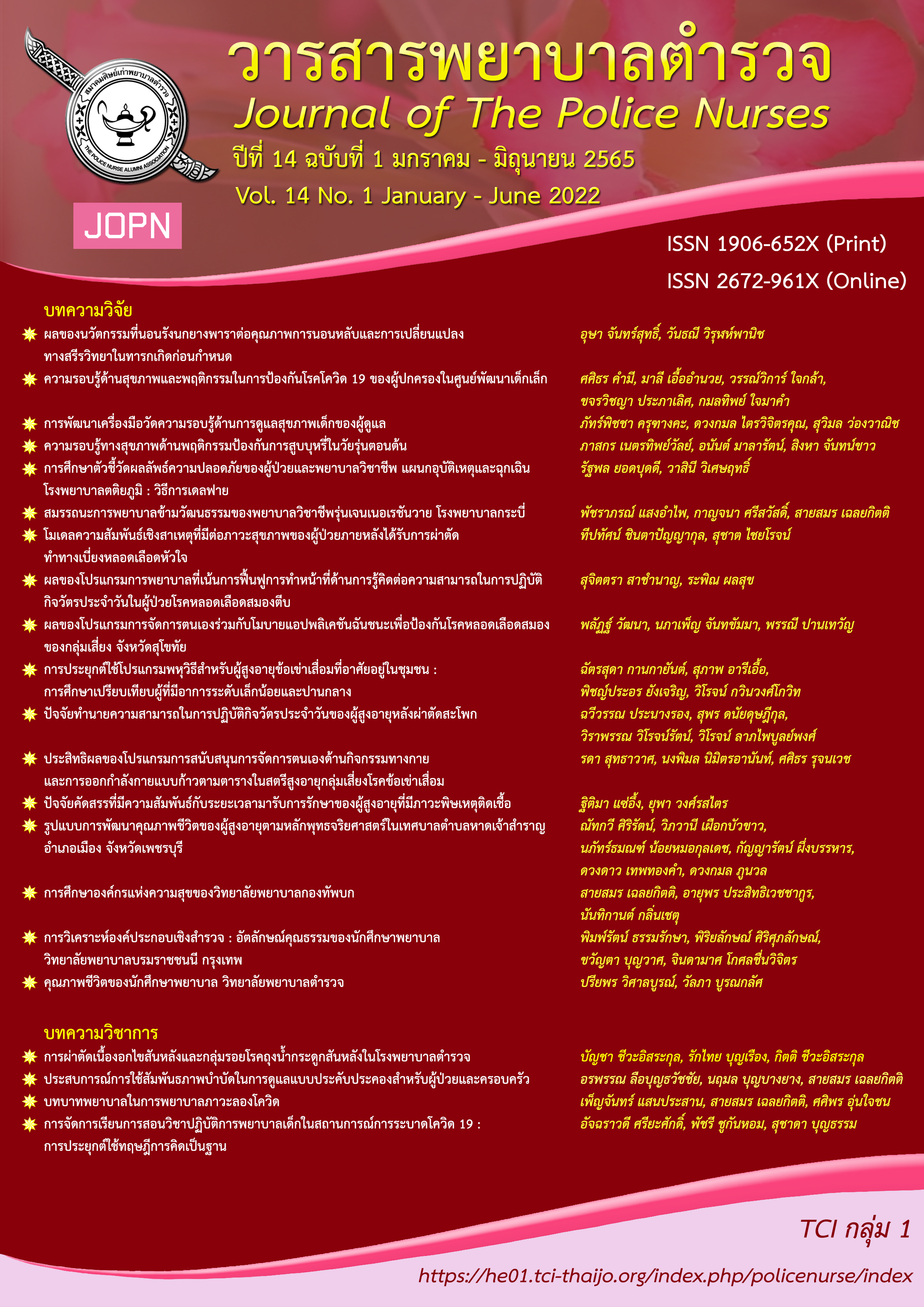HEALTH LITERACY FOR SMOKING PREVENTIVE BEHAVIORS AMONG EARLY ADOLESCENTS
Keywords:
health literacy, smoking preventive behaviors, early adolescentsAbstract
This research was conducted to review the literature and synthesized components and indicators of health literacy for smoking prevention behaviors among early adolescents. Then, several aspects such as the objectivity, validity, appropriateness, feasibility of components, and health literacy indicators for smoking prevention behaviors among early adolescents were assessed and summarized as a model for indicators of health literacy for smoking prevention behaviors among early adolescents. The research method was divided into two steps: 1) A systematic review of the literature; and 2) An outline of the indicators and components of health literacy for smoking prevention behaviors among early adolescents. Seventeen experts validated the appropriateness and feasibility of Delphi Study metrics using median and interquartile ranges and summarized them as components of health literacy indicators for smoking prevention behaviors among early adolescents.
The results showed that the majority of health literacy components and indicators for smoking prevention behaviors among early adolescents focused on training skills and abilities or competencies on an individual level. Furthermore, most of them reflected independent abilities and competencies. There were six components and twenty-five indicators: 1) Access to data (5 indicators), 2) Data analysis (4 indicators), 3) Cognitive performance (3 indicators), 4) Social skills (3 indicators), 5) Decision making (5 indicators), and 6) Self-management (5 indicators), with a median value greater than 3.50 and no more than 1.50 interquartile ranges.
Downloads
References
Duncan, L. R., Pearson, E. S., & Maddison, R. (2017). Smoking prevention in children and adolescents: A systematic review of individualized interventions. Patient Education and Counseling, 101(3), 375-388. https://doi.org/10.1016/j.pec.2017.09.011
Edwards, M., Wood, F., Davies, M., & Edwards, A. (2012). The development of health literacy in patients with a long-term health condition: The health literacy pathway model. BMC public health, 12(1), 130-130. https://doi.org/10.1186/1471-2458-12-130
Green, R. A. (2014). The Delphi technique in educational research. Sage Open, 4(2), 2158244014529773.
Health Education Division Department of Health Service Support Ministry of Public Health. (2018). Assessment and strengthening the health literacy and health behavior among teenage and adult aged 15 years and overpopulation.
Health Education Division, Department of Health Service Support Ministry of Public Health, Bangkok.
Ishikawa, H., & Kiuchi, T. (2010). Health literacy and health communication. BioPsychoSocial Medicine, 4(1), 18. https://doi.org/10.1186/1751-0759-4-18
Kaeodumkoeng, K. (2018). Health literacy: Access, Understand and Application. Bangkok: Amarin Printing and Publishing Public Company Limited.
Kaeodumkoeng, K., & Tripetchsriurai, N. (2011). Health literacy. Health Education Division, Department of Health Service Support Ministry of Public Health, Bangkok.
Kaseampakdee, J., Theppasuit, S., & Sakea, P. (2015). The behavioral health 3E 2S among residents aged 15 years old and over in the area of health behavior in their own village in Phetchaburi province. Journal of Health Education and Communication, 1(1), 30-42.
Kickbusch, I. (2008). Health literacy: An essential skill for the twenty-first century. Health Education, 108(2), 101-104. https://doi.org/10.1108/09654280810855559
National Statistical office. (2022). Health branch: Risk and protective factors and health status. Retrieved from https://www.statbbi.nso.go.th/staticreport/page/sector/en/05.aspx
Nutbeam, D. (2008). The evolving concept of health literacy. Social Science and Medicine, 67(12), 2072-2078. https://doi.org/10.1016/j.socscimed.2008.09.050
Pitayarangsarit, S., & Punkrajang, P. (2019). Tobacco consumption control situation in Thailand 2019. Bangkok: CDMK printing.
Ra, J. S., & Jung, M. S. (2018). School-related factors affecting smoking intention among Korean middle school students. Applied Nursing Research, 39, 34-40. https://doi.org/10.1016/j.apnr.2017.1.007
Shum, J., Poureslami, I., Doyle-Water, M., & FitzGerald , M. (2016). The application of health literacy measurement tools (collective or individual domains) in assessing chronic disease management: A systematic review protocol. Systematic Reviews, 5(1), 97. https://doi.org/10.1186/s13643-016-0267-8
Suramitmaitree, B. (2013). Health literacy and operation situation enhance the health intelligence of Thai people in order to support the ASEAN community. Bangkok: Ministry of Foreign Affairs.
Sørensen, K., van den Broucke, S., Fullam. J., Doyle, G., Pelikan, J., & Slonska, Z. (2012). Health literacy and public health: A systematic review and integration of definitions and models. BMC public health, 12, 80-80. https://doi.org/10.1186/1471-2458-12-80
World Health Organization (WHO). (2009). Health literacy and health promotion definitions, concepts and examples in the Eastern Mediterranean region individual empowerment conference working document. Nairobi, Kenya.
Wu, A. D., Begoray, D. L., Macdonald, M., Higgins, J. W., Frankish, J., Kwan, B., . . . Rootman, I. (2010). Developing and evaluating a relevant and feasible instrument for measuring health literacy of Canadian high school students. Health Promotion International, 25(4), 444-452. http://dx.doi.org/10.1093/heapro/daq032
Downloads
Published
How to Cite
Issue
Section
License
Copyright (c) 2022 JOURNAL OF THE POLICE NURSES

This work is licensed under a Creative Commons Attribution-NonCommercial-NoDerivatives 4.0 International License.
ผลงานที่ได้ตีพิมพ์แล้วจะเป็นลิขสิทธิ์ของวารสารพยาบาลตำรวจ















